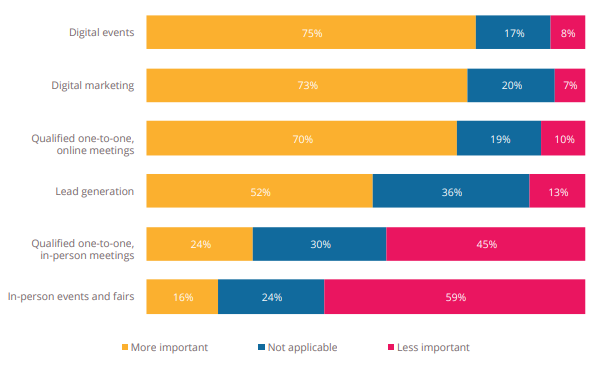
Higher education is in the midst of a revolution. Mergers, acquisitions, strategic alliances and digital transformations are dramatically reshaping the industry. The COVID-19 crisis has hit the industry hard and driven students online.
It’s a time of almost unprecedented change. In the US, the number of higher education mergers and acquisitions has soared from 12 in the 2000s to 22 between 2010 and 2017.
Unsurprisingly, the volume and pace of this change is unsettling for staff. Their roles, working environments and even employers are changing. It’s a trend experts are predicting will continue, with increasing numbers of colleges, universities and community colleges likely to close or merge in the next decade.
In changing times, leadership is the difference between prevailing and failing. Strong leadership communication enables positive change – smoothing transitions and optimally positioning for success.
These communication tactics will help higher education leadership step up to the challenge.
1. Drive A Unique Vision
Of all the leadership issues in higher education, the coronavirus is the most significant. Universities find themselves surrounded by uncertainty, where the full impact of the crisis on global higher education is unknown.
More than 50% of educators believe COVID-19 will have a detrimental effect on the number of student enrolments, with the fall in revenues feared to be as high as US$4.5 billion.
Creating and communicating a vision statement for their institution is important for leaders to look ahead with confidence. This statement must crystalize the value offered and what makes the institution unique in the post-virus world.
Consider why an applicant should enroll in your university. What do you do better than any other institution? What is your vision for future students – and how is that vision different from today?
Digital channels have increased in importance and should be at the core of leadership planning.

(Source: QS Quacquarelli Symonds)
2. Champion The Cause
One of the biggest obstacles to navigating change is overcoming the natural resistance to it.
Leaders can address this by flipping the negative – inspiring staff about the end state, not fixating on the growing pains of getting there. Through effective use of internal communications, a future-oriented vision for the organization can be advanced.
Promoting a strategic vision in this way was proven to positively influence success in a study of nearly 40 higher education mergers since 2000.
Position benefits in a way that resonate with staff. Let them know how the changes will improve their job satisfaction? Why will their jobs become more valuable? Championing the positive outcomes of the change helps undermine the causes of resistance.
3. Build A Strong Presence
Strong leadership skills are critical to the change management process. Faculty leaders must allay staff concerns and insecurities while providing clear direction. Visible ‘open door leadership’ is essential for this to be successful. Staff won’t feel reassured about the change or motivated to invest in its success if leaders aren’t demonstrably behind it.
While a strong physical presence is ideal, the reality of online learning, multi-campus faculties and dispersed staff will often make this unachievable. Digital communication can fill these gaps. Connecting with staff through video updates is an effective way to provide information and convey sincerity to everyone concerned. Don’t rely on emails, as they often lack emotional resonance.
In times of change, there’s no substitute for leadership visibility in minimizing negative speculation and fostering positive attitudes. If you can’t be there in person, be everywhere digitally.
4. Foster Closer Relationships
Change is likely to be a significant cause of tension across departments. Whether a restructure, merger or other large-scale initiative, different units within the organization can find their interests in conflict.
In this environment, leadership communications can be instrumental in building trust across campuses and faculties. Sharing of resources and co-hosting of events are good ways to facilitate closer relationships.
Employ culture-building messages that convey a sense of “better together.” This is especially critical when changes involve parties with markedly different backgrounds, such as mergers between commercial and not-for-profit organizations.
Remember that building culture is never an overnight success. It’s a slow-burn process that requires more passive communication channels to gradually influence employee behavior. The Hong Kong University of Science and Technology created a communication campaign to achieve this, achieving a 20% increase in response rates.
5. Project Positivity
Higher education institutions rely heavily on a positive standing in the marketplace. This is essential for maintaining the enrolment and funding levels needed to operate in a highly competitive market. Times of major change can put this at risk.
Publicizing the reasons for and benefits of the change is traditionally the province of external PR. However, internal communications can exert a stronger influence on academic visibility in the market than external communication. This is because staff and students promote the organization’s image externally through their daily interactions with various audiences.
Projecting positivity to staff is therefore essential for influencing external perceptions. Continue to reinforce key benefits such as strengthening for future growth, adapting to emerging markets and improving operational performance.
A key role of leadership communications is stabilizing the ship while embroiled in change. Managing market perceptions through employee messaging is one means of achieving this.

6. Tackle The Tough Questions
In any major change initiative, the two most-asked questions by staff are ‘What was wrong with the old structure?’ and ‘How will we be better off under the new structure?’ Higher education leaders who can’t readily answer these questions cannot expect staff to get on board.
When setting your communication strategy, plan to tackle these questions as early as possible. Ideally immediately following the formal announcement of the change, or as part of this announcement if made internally first.
Messages this important should be delivered in a format reserved for high-priority communications. Use colors and content styles that convey importance. Deliver to staff via channels that grab attention. Don’t be tempted to use unsuitable channels, like collaboration tools – this is likely to see messages overlooked and staff left in the dark.
Front-footing these questions provides essential reassurance for staff that executives are mindful of their concerns.
7. Maintain Communication Consistency
Change communication in higher education is more a journey than a destination. Keeping staff informed doesn’t stop when the change is implemented. The most important element in change success is regular, open, honest communication throughout.
Post-implementation communication is especially valuable given that the benefits of changes are often only revealed over time. The focus of messaging should then switch to improving user adoption and encouraging behavioral change.
Reinforce key messages and provide direction for further information through employee screensavers and digital signage in common areas. Introduce staff surveys to canvas feedback and identify any obstacles that could impede success. These also provide sought-after transparency for staff and a valuable check-in for how they’re feeling.
Good leadership communication is essential to engage academic and administrative staff, especially in times of change like COVID-19. Following these tips will ensure your institution becomes a study in success.


